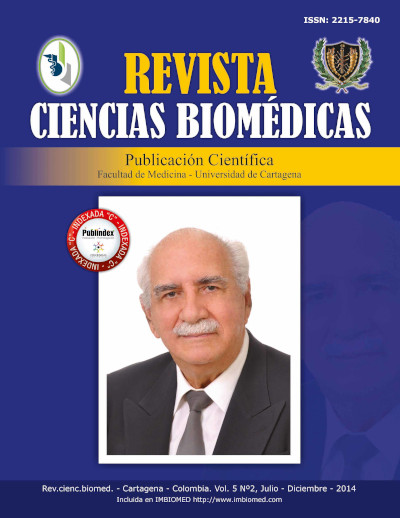Ébola, lo que debemos saber
Ébola, lo que debemos saber
Contenido principal del artículo
Resumen
La entidad conocida como ébola, recibe esa denominación por el nombre del río más cercano al distrito africano, donde se presentaron los primeros casos del brote en la década de los setenta del siglo XX (1). Esta zoonosis que está afectando a África y actualmente extendiéndose a otros
continentes, llama la atención de las autoridades sanitarias a nivel mundial.
Los virus pertenecen a la familia Filoviridae, género Ebolavirus (EBOV) y están divididos en las especies Bundibugyo ebolavirus, Reston ebolavirus, Sudan ebolavirus, Tai Forest ebolavirus y Zaire ebolavirus (2).
Palabras clave
Descargas
Datos de publicación
Perfil evaluadores/as N/D
Declaraciones de autoría
- Sociedad académica
- Universidad de Cartagena
- Editorial
- Universidad de Cartagena
Detalles del artículo
Referencias (VER)
Emond RT, Evans B, Bowen ET, Lloyd G. Ebola virus infections.
British Medical J. 1977;2(6086):539-40.
Adams MJ, King AM, Carstens EB. Ratification vote on taxonomic proposals to the International Committee on Taxonomy of Viruses (2013). Arch Virol. 2013;158(9):2023-30.
Brès P. [The epidemic of Ebola haemorrhagic fever in Sudan and Zaire, 1976: introductory note]. Bull World Health Organ. 1978;56(2):245.
Georges AJ, Leroy EM, Renaut AA, Benissan CT, Nabias RJ, Ngoc MT, et al. Ebola hemorrhagic fever outbreaks in Gabon, 1994-1997: epidemiologic and health control issues. J Infect Dis. 1999;179 Suppl 1:S65-75.
Khan AS, Tshioko FK, Heymann DL, Le Guenno B, Nabeth
P, Kerstiens B, et al. The reemergence of Ebola hemorrhagic fever, Democratic Republic of the Congo, 1995. Commission de Lutte contre les Epidemies a Kikwit. J Infect Dis. 1999;179 Suppl 1:S76-86.
Okware SI, Omaswa FG, Zaramba S, Opio A, Lutwama
JJ, Kamugisha J, et al. An outbreak of Ebola in Uganda. Trop Med Int Health. 2002;7(12):1068-75.
Organization WH. Ebola virus disease update -west Africa. http://www.who.int/2014 [updated 04/09/2014].
Organization WH. Ebola virus disease – Democratic Republic of Congo. http://www.who.int/2014 [updated 27/08/2014].
Leirs H, Mills JN, Krebs JW, Childs JE, Akaibe D, Woollen N, et al. Search for the Ebola virus reservoir in Kikwit, Democratic Republic of the Congo: reflections on a vertebrate collection. J Infect Dis.
;179 Suppl 1:S155-63.
Reiter P, Turell M, Coleman R, Miller B, Maupin G, Liz J, et al. Field investigations of an outbreak of Ebola hemorrhagic fever, Kikwit, Democratic Republic of the Congo, 1995: arthropod studies. J Infect Dis. 1999;179 Suppl 1:S148-54.
Jahrling PB, Geisbert TW, Dalgard DW, Johnson ED, Ksiazek TG, Hall WC, et al. Preliminary report: isolation of Ebola virus from monkeys imported to USA. Lancet. 1990;335(8688):502-5.
Morvan JM, Deubel V, Gounon P, Nakoune E, Barriere P, Murri S, et al. Identification of Ebola virus sequences present as RNA or DNA in organs of terrestrial small mammals of the Central African Republic. Microbes Infect. 1999;1(14):1193-201.
Roddy P, Howard N, Van Kerkhove MD, Lutwama J, Wamala J, Yoti Z, et al. Clinical manifestations and case management of Ebola haemorrhagic fever caused by a newly identified virus strain, Bundibugyo, Uganda, 2007-2008. PLoS One. 2012;7(12):e52986.
Geisbert TW, Hensley LE, Jahrling PB, Larsen T, Geisbert JB, Paragas J, et al. Treatment of Ebola virus infection with a recombinant inhibitor of factor VIIa/tissue factor: a study in rhesus monkeys. The Lancet. 2003;362(9400):1953-8.
Qiu X, Wong G, Audet J, Bello A, Fernando L, Alimonti
JB, et al. Reversion of advanced Ebola virus disease in nonhuman primates with ZMapp. Nature. 2014;(AOP) doi:10.1038/nature13777



 PDF
PDF
 FLIP
FLIP





